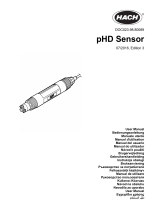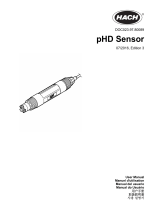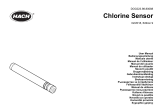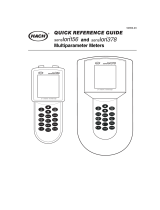Page is loading ...

INSTRUCTION MANUAL
HI83306
Environmental Analysis Photometer

Thank you for choosing a Hanna Instruments product.
Please read this instruction manual carefully before using the instrument.
This manual will provide you with the necessary information for correct use of the
instrument, as well as a precise idea of its versatility.
If you need additional technical information, do not hesitate to e‑mail us at
[email protected] or view our worldwide contact list at www.hannainst.com.
All rights are reserved. Reproduction in whole or in part is prohibited without the written consent of
the copyright owner, Hanna Instruments Inc., Woonsocket, Rhode Island, 02895, USA.
Dear
Customer,

3
TABLE OF CONTENTS
5
5
7
7
9
11
11
14
15
6
7
8
10
11
14
15
16
17
17
1. PRELIMINARY EXAMINATION ............................................................................................
2. SAFETY MEASURES...................... ....................................................................................
3. SPECIFICATIONS ..............................................................................................................
4. DESCRIPTION..... .............................................................................................................
4.1. GENERAL DESCRIPTION.............................................................................................
4.2. PRECISION AND ACCURACY........................................................................................
4.3. FUNCTIONAL DESCRIPTION........................................................................................
4.4. PRINCIPLE OF OPERATION.........................................................................................
4.5. OPTICAL SYSTEM......................................................................................................
5. GENERAL OPERATIONS......... ............................................................................................
5.1. POWER CONNECTION AND BATTERY MANAGEMENT......................................................
5.2. GENERAL SETUP........................................................................................................
5.3. USING HANNA DIGITAL ELECTRODES...........................................................................
5.4. MODE SELECTION.....................................................................................................
5.5. LOGGING DATA.........................................................................................................
5.6. ADDING SAMPLE / USER NAMES TO LOG DATA............................................................
5.7. DATA MANAGEMENT..................................................................................................
5.8. CONTEXTUAL HELP....................................................................................................
6. PHOTOMETER MODE......... ...............................................................................................
6.1. METHOD SELECTION.................................................................................................
6.2. COLLECTING AND MEASURING SAMPLES AND REAGENTS..............................................
6.2.1. PROPER USE OF SYRINGE...................................................................................
6.2.2. PROPER USE OF DROPPER...................................................................................
6.2.3. PROPER USE OF POWDER PACKET.........................................................................
6.3. CUVETTE PREPARATION.............................................................................................
6.4. TIMERS AND MEASUREMENT FUNCTIONS...................................................................
6.5. CHEMICAL FORMULA / UNIT CONVERSIONS................................................................
6.6. METER VALIDATION / CAL CHECK................................................................................
6.7. ABSORBANCE MEASUREMENTS..................................................................................
7. PROBE MODE................... ...............................................................................................
7.1. pH CALIBRATION......................................................................................................
7.2. pH CALIBRATION MESSAGES......................................................................................
7.3. pH MEASUREMENT...................................................................................................
7.4. pH MEASUREMENT MESSAGES / WARNINGS...............................................................
7.5. pH GLP.....................................................................................................................
7.6. pH ELECTRODE CONDITIONING AND MAINTENANCE.....................................................
17
18
18
18
18
19
20
21
21
22
23
23
25
25
27
28
29

4
TABLE OF CONTENTS
31
31
37
43
48
52
56
61
66
34
40
46
50
54
58
64
69
71
74
8. METHOD PROCEDURES........ ........................................................................................
8.1. AMMONIA LOW RANGE..............................................................................................
8.2. AMMONIA MEDIUM RANGE........................................................................................
8.3. AMMONIA HIGH RANGE.............................................................................................
8.4. CHLORINE, FREE.......................................................................................................
8.5. CHLORINE, TOTAL.....................................................................................................
8.6. CHROMIUM (VI) LOW RANGE.....................................................................................
8.7. CHROMIUM (VI) HIGH RANGE....................................................................................
8.8. COLOR OF WATER.....................................................................................................
8.9. COPPER LOW RANGE.................................................................................................
8.10. COPPER HIGH RANGE..............................................................................................
8.11. CYANURIC ACID......................................................................................................
8.12. MOLYBDENUM.......................................................................................................
8.13. NICKEL LOW RANGE................................................................................................
8.14. NICKEL HIGH RANGE...............................................................................................
8.15. NITRATE................................................................................................................
8.16. NITRITE HIGH RANGE..............................................................................................
8.17. OXYGEN, DISSOLVED...............................................................................................
8.18. pH........................................................................................................................
8.19. PHOSPHATE LOW RANGE.........................................................................................
8.20. PHOSPHATE HIGH RANGE........................................................................................
8.21. SILICA LOW RANGE.................................................................................................
8.22. SILVER..................................................................................................................
8.23. ZINC......................................................................................................................
9. WARNINGS & ERRORS......... ............................................................................................
10. STANDARD METHODS......... ...........................................................................................
11. ACCESSORIES................................................................................................................
11.1. REAGENT SETS.......................................................................................................
11.2. pH ELECTRODES.....................................................................................................
11.3. pH SOLUTIONS.......................................................................................................
11.4. OTHER ACCESSORIES..............................................................................................
12. ABBREVIATIONS............................................................................................................
CERTIFICATION ...................................................................................................................
RECOMMENDATIONS FOR USERS..........................................................................................
WARRANTY.........................................................................................................................
76
78
81
84
88
91
94
95
95
97
98
99
101
102
103
103

5
1. PRELIMINARY EXAMINATION
Remove the instrument and accessories from the packaging and examine it carefully to make sure
that no damage has occurred during shipping. Notify your nearest Hanna Customer Service Center if
damage is observed.
Each HI83306 is supplied with:
• Sample Cuvette and Cap (4 pcs.)
• Cloth for Wiping Cuvettes
• Scissors
• USB Cable
• 5 Vdc Power Adapter
• Instruction Manual
• DO bottle (glass stopper bottle)
• Quality Certificate
Note: Save all packing material until you are sure that the instrument works correctly.
Any damaged or defective item must be returned in its original packing material with the
supplied accessories.
2. SAFETY MEASURES
•The chemicals contained in the reagent kits may be hazardous if improperly
handled.
•Read the Safety Data Sheets (SDS) before performing tests.
• Safety equipment: Wear suitable eye protection and clothing when required, and follow
instructions carefully.
• Reagent spills: If a reagent spill occurs, wipe up immediately and rinse with plenty of water. If
reagent contacts skin, rinse the affected area thoroughly with water. Avoid breathing released
vapors.
• Waste disposal: for proper disposal of reagent kits and reacted samples, contact a licensed
waste disposal provider.
PRELIMINARY EXAMINATION SAFETY MEASURES

6
SPECIFICATIONS
Measurement Channels
4 x optical channels
1 x digital electrode channel (pH measurement)
Absorbance
Range 0.000 to 4.000 Abs
Resolution 0.001 Abs
Accuracy ±0.003 Abs (at 1.000 Abs)
Light Source light emitting diode
Bandpass Filter Bandwidth 8 nm
Bandpass Filter Wavelength Accuracy ±1.0 nm
Light Detector silicon photocell
Cuvette Types round, 24.6 mm diameter
Number of Methods 27
pH
Range ‑2.00 to 16.00 pH (± 1000.0 mV)*
Resolution 0.01 pH (0.1 mV)
Accuracy ±0.01 pH (±0.2 mV) (@ 25 °C / 77 °F)
Temperature Compensation ATC (‑5.0 to 100.0 °C; 23.0 to 212.0 °F)*
Calibration
2 points, eligible from 5 available buffers (4.01,
6.86, 7.01, 9.18, 10.01 pH)
Electrode Intelligent pH / temperature electrode
Temperature
Range ‑20.0 to 120.0°C (‑4.0 to 248.0 °F)
Resolution 0.1 °C (0.1 °F)
Accuracy ±0.5 °C (±0.9 °F) (@ 25 °C / 77 °F)
Additional
Specifications
Logging 1000 readings (mixed photometer and electrode)
Display 128 x 64 pixel B/W LCD with backlight
USB‑A (Host) Functions mass‑storage host
USB‑B (Device) Functions power input, mass‑storage device
Battery Life
> 500 photometer measurements, or 50 hours of
continuous pH measurement
Power Supply
5 Vdc USB 2.0 power adapter/type micro‑B connector
3.7 Vdc Li‑polymer rechargeable battery,
non‑serviceable
Environment
0 to 50 °C (32 to 122 °F);
0 to 95% RH, non‑serviceable
Dimensions 206 x 177 x 97 mm (8.1 x 7.0 x 3.8")
Weight 1.0 kg (2.2 lbs.)
3. SPECIFICATIONS
*Limits will be reduced to actual probe/sensor limits.

7
DESCRIPTION
4. DESCRIPTION
4.1.GENERAL DESCRIPTION
HI83306 multiparameter photometer is compact and versatile meter with two measurement
modes: Absorbance and pH/ mV. Absorbance mode include CAL Check feature and 27 different
methods that cover a wide variety of applications, making it ideal for both benchtop and portable
operation.
• Digital electrode input for pH measurements
• Certified CAL Check cuvettes to confirm meter functionality
• Dual purpose micro‑USB flash drive
• Li‑polymer rechargeable battery
• Auto‑off
• Absorbance mode
• User and sample name entry
• GLP features
4.2.PRECISION AND ACCURACY
Precision is how closely repeated measurements
are to one another. Precision is usually expressed
as standard deviation (SD).
Accuracy is defined as the closeness of a test
result to the true value.
Although good precision suggests good accuracy,
precise results can be inaccurate. The figure
explains these definitions.
For each method, the accuracy is expressed in the
related measurement section.

8
DESCRIPTION
1) Splash‑proof keypad
2) Liquid Crystal Display (LCD)
3) Indexing mark
4) Protective port covers
5) Light‑blocking cover panel
6) Cuvette holder
7) ON/OFF power button
8) 3.5 mm TRRS (jack) input for digital electrodes
9) Standard USB host connector for data transfer to a USB flash drive
10) Micro‑USB device connector for power or PC interface
4.3. FUNCTIONAL DESCRIPTION

9
DESCRIPTION
Keypad Description
The keypad contains 12 direct keys and 3 functional keys with the following functions:
Press the functional keys to perform the function displayed above them on the LCD.
Press to access the list of photometer methods.
Press to move up in a menu or a help screen, to increment a set value, or to access
second level functions.
Press to toggle between photometer and pH (electrode) mode.
Press to move left in a menu or to decrement a set value.
Press to move down in a menu or a help screen, to decrement a set value, or to access
second level functions.
Press to move right in a menu or to increment a set value.
Press to access the setup screen.
Press to log the current reading.
Press to review saved logs.
Press to exit the current screen.
Press to display the help screen.
ON/OFF power button.
4.4. PRINCIPLE OF OPERATION
Absorption of light is a typical phenomenon of interaction between electromagnetic radiation and
matter. When a light beam crosses a substance, some of the radiation may be absorbed by atoms,
molecules or crystal lattices.
If pure absorption occurs, the fraction of light absorbed depends both on the optical path length
through the matter and on the physical‑chemical characteristics of the substance according to the
Lambert‑Beer Law:
‑log I/I
o
= e
l
c d
or
A = e
l
c d

10
DESCRIPTION
Instrument Block Diagram
The internal reference system (reference detector) of the HI83306 photometer compensates for any
drifts due to power fluctuations or ambient temperature changes, providing a stable source of light
for your blank (zero) measurement and sample measurement.
LED light sources offer superior performance compared to tungsten lamps. LEDs have a much higher
luminous efficiency, providing more light while using less power. They also produce little heat,
which could otherwise affect electronic stability. LEDs are available in a wide array of wavelengths,
whereas tungsten lamps have poor blue/violet light output.
Improved optical filters ensure greater wavelength accuracy and allow a brighter, stronger signal to
be received. The end result is higher measurement stability and less wavelength error.
A focusing lens collects all of the light that exits the cuvette, eliminating errors from cuvette
imperfections and scratches, eliminating the need to index the cuvette.
4.5. OPTICAL SYSTEM
I
o
= intensity of incident light beam
I = intensity of light beam after absorption
e
l
= molar extinction coefficient at wavelength l
c = molar concentration of the substance
d = optical path through the substance
Therefore, the concentration "c" can be calculated from the absorbance of the substance as the
other factors are constant.
Photometric chemical analysis is based on specific chemical reactions between a sample and
reagent to produce a light‑absorbing compound.

11
DESCRIPTION
5. GENERAL OPERATIONS
5.1. POWER CONNECTION AND BATTERY MANAGEMENT
The meter can be powered from an AC/DC adapter (included) or from the built‑in rechargeable battery.
The meter will perform an auto‑diagnostic test when it is first powered on. During this test, the
HANNA
®
logo will appear on the LCD. After 5 seconds, if the test was successful, the last method
used will appear on the display. The battery icon on the LCD will indicate the battery status:
‑ battery is charging from external adapter ‑ battery fully charged (meter connected to AC/DC adapter)
‑ battery capacity (no external adapter) ‑ battery near 0% (no external adapter)
‑ battery exhausted (no external adapter)
To conserve battery, the meter will turn off automatically after 15 minutes of inactivity (30 minutes
before a READ measurement). If a photometer measurement is on the screen, an auto‑log is
created before shutdown.
5.2. GENERAL SETUP
Press SETUP key to enter in Setup menu, highlight desired option using and press Select.
CAL Check (Photometer Only)
Press Select to enter the CAL Check screen. The date, time and
values for the last CAL Check are displayed on the screen.
To start a new CAL Check press Check key and follow the prompts
on the screen.

12
GENERAL OPERATIONS
Backlight
Values: 0 to 8
Press the Modify key to access the backlight intensity.
Use the functional keys or the keys to increase or decrease
the value.
Press the Accept key to confirm or ESC to return to the Setup
menu without saving the new value.
Contrast
Values: 0 to 20
Press the Modify key to change the display’s contrast.
Use the functional keys or the keys to increase or decrease
the value.
Press the Accept key to confirm the value or ESC to return to the
Setup menu without saving the new value.
Date / Time
Press the Modify key to change the date/time.
Press the functional keys or the keys to highlight the value
to be modified (year, month, day, hour, minute or second).
Use the keys to change the value.
Press the Accept key to confirm or ESC to return to the Setup
without saving the new date or time.
Time Format
Option: AM/PM or 24-hour
Press the functional key to select the desired time format.
Temperature Unit (pH Only)
Option: °C or °F
Press the functional key to select the desired temperature unit.

13
GENERAL OPERATIONS
Date Format
Press the Modify key to change the Date Format.
Use the keys to select the desired format.
Press the Select key to confirm or ESC to return to the Setup menu
without saving the new format.
Decimal Separator
Option: Comma ( , ) or Period ( . )
Press the functional key to select the desired decimal separator.
The decimal separator is used on the measurement screen and
CSV files.
Language
Press the Modify key to change the Language. Use the
keys to select the desired language.
Press Select to choose one of the 7 languages installed.
Beeper
Option: Enable or Disable
When enabled, a short beep is heard every time a key is pressed.
A long beep alert sounds when the pressed key is not active or an
error is detected. Press the functional key to enable/disable the
beeper.
Instrument ID
Option: 0 to 999999
This option is used to set the instrument’s ID (identification
number). Press the Modify key to access the instrument ID screen.
Use the functional keys or the keys to highlight the digit
to be modified. Press the keys in order to set the desired
value. Press the Accept key to confirm the value or ESC to return
to the Setup menu without saving the new value.

14
GENERAL OPERATIONS
Meter Information
Press the Select key to view the model, serial number, firmware
version and selected language. Press ESC to return to the Setup
menu.
Probe Information (pH mode only)
Press the Select key to view model number, serial number and
firmware version for the connected probe.
Press ESC to return to the Setup menu.
5.3. USING HANNA DIGITAL ELECTRODES
The HI83306 can be used to perform direct pH measurements by connecting a HANNA
®
digital
pH electrode with a 3.5 mm TRRS connector. To begin taking probe measurements, connect the
electrode to the 3.5 mm port marked with “EXT PROBE” located at the rear of the meter. If the
meter is in “Photometer Mode”, set the meter to “Probe Mode” by pressing the MODE key.
5.4. MODE SELECTION
The HI83306 has two operational modes: Photometer Mode and Probe Mode.
Photometer Mode enables on‑demand measurement of a cuvette using the integrated optical
system. Photometric‑related functions, such as Method selection, Zero, Read, and Timers are
available in this mode.
Probe Mode enables continuous measurement using a Hanna Digital Electrode connected to the
3.5 mm port. Probe‑related functions, such as calibration and GLP, are available in this mode.
To switch between Photometer Mode and Probe Mode, use the
button.
Note: The active mode cannot be switched while in menus, such as Setup, Recall, Method, etc.

15
GENERAL OPERATIONS
5.5. LOGGING DATA
The instrument features a data log function to help you keep track of all your analysis. The data log
can hold 1000 individual measurements. Storing, viewing and deleting the data is possible using
the LOG and RECALL keys.
Storing data: You can store only a valid measurement. Press LOG and the last valid
measurement will be stored with date and time stamp.
5.6. ADDING SAMPLE / USER NAMES TO LOG DATA
A sample ID and user ID can be added to the saved log. Use the keys to highlight the
Sample ID or User ID then press Modify.
Text Entry
Sample ID and User ID care entered using the alphanumeric multi‑tapping keypad.
Enter one character at a time by pressing the key with the assigned character repeatedly until the
desired character is highlighted. For reference, a list of the characters available for the current key
will be shown under the text box.
The character will be entered after a two‑second delay or after another key is pressed.
Once all characters have been entered, press Accept to use the displayed text.

16
GENERAL OPERATIONS
The following functions are available during Text Entry:
• Accept: Press to accept the current displayed text.
• Arrow: Press to delete the last character.
• Clear: Press to delete all characters.
Press to discard all changes and return to the previous screen.
Viewing and deleting: You can view, export and delete the data by pressing the RECALL key. Use
the keys to scroll through the saved logs. Press Info to view additional information about
the selected log.
Data Export:
Log data can be exported to a USB flash drive or to a PC. To access Data Export functions, press
Recall then Export.
Use the keys to select the desired export location.
For export to USB Flash Drive, insert the USB Flash Drive into the dedicated port at the back of the
meter labeled HOST USB, then follow the on‑screen prompts.
For export to PC, connect the meter to a PC using the supplied micro‑USB cable. Insert the cable
into the port at the back of the meter labeled PC PWR. Follow the on‑screen prompts. When the
meter says PC connected, use a file manager (such as Windows Explorer or Mac Finder) to move the
file from the meter to the PC. The meter will appear as a removable disk.
5.7. DATA MANAGEMENT

17
GENERAL OPERATIONS
5.8. CONTEXTUAL HELP
HI83306 offers an interactive contextual help mode that assists the user at any time.
To access the help screen press HELP.
The instrument will display additional information related to the
current screen. To read all the available information, scroll the text
using the keys.
To exit help mode press ESC key and the meter will return to the
previous screen.
Log data is exported as a single file containing all logged photometer and probe data. The file
name is: “HI83306.csv”. The CSV file (Comma‑Separated Values) may be opened with a text
editor or spreadsheet application.
6. PHOTOMETER MODE
6.1. METHOD SELECTION
In order to select the desired method press the METHOD key and a screen with the available
methods will appear.
Press the keys to highlight the desired method. Press Select.
After the desired method is selected, follow the procedure described in the related section.
Before performing a method read all the instructions carefully.
PHOTOMETER MODE

18
6.2. COLLECTING AND MEASURING SAMPLES AND REAGENTS
6.2.1. PROPER USE OF SYRINGE
(a) Push the plunger completely into the syringe and insert the tip
into the solution.
(b) Pull the plunger up until the lower edge of the seal is exactly on
the mark for the desired volume.
(c) Take out the syringe and clean the outside of the syringe tip, be
sure that no drops are hanging on the tip of the syringe. Then,
keeping the syringe in vertical position above the cuvette, push
the plunger down into the syringe, the desired volume has been
delivered into the cuvette.
6.2.2. PROPER USE OF DROPPER
(a) For reproducible results, tap the dropper on the table several times and wipe the outside of the
tip with a cloth.
(b) Always keep the dropper bottle in a vertical position while dosing the reagent.
6.2.3. PROPER USE OF POWDER PACKET
(a) Use scissors to open the powder packet
(b) Push the edges of the packet to form a spout
(c) Pour out the content of the packet.
PHOTOMETER MODE

19
PHOTOMETER MODE
6.3. CUVETTE PREPARATION
Proper mixing is very important for reproducibility of the measurements. The proper mixing
technique for each method is listed in the method procedure.
(a) Invert the cuvette a couple of times or for a specified time: hold the cuvette in the vertical
position. Turn the cuvette upside‑down and wait for all of the solution to flow to the cap end,
then return the cuvette to the upright vertical position and wait for all of the solution to flow to
the cuvette bottom. This is one inversion. The correct speed for this mixing technique is
10‑15 complete inversions in 30 seconds.
This mixing technique is indicated with “invert to mix” and the following icon:
(b) Shaking the cuvette, moving the cuvette up and down. The movement may be gentle or
vigorous. This mixing method is indicated with “shake gently” or “shake vigorously”, and one
of the following icons:
In order to avoid reagent leaking and to obtain more accurate measurements,
close the cuvette first with the supplied HDPE plastic stopper
and then the
black cap.
Whenever the cuvette is placed into the measurement holder, it must be dry
outside and free of fingerprints, oil or dirt. Wipe it thoroughly with HI731318 or
a lint‑free cloth prior to insertion.
Shaking the cuvette can generate bubbles in the sample, causing higher
readings. To obtain accurate measurements, remove such bubbles by swirling or
by gently tapping the cuvette.
shake gently shake vigorously

20
PHOTOMETER MODE
Do not let the reacted sample stand too long after reagent is added. For best accuracy, respect the
timings described in each specific method.
It is possible to take multiple readings in a row, but it is recommended
to take a new zero reading for each sample and to use the same cuvette
for zeroing and measurement when possible.
Discard the sample immediately after the reading is taken, or the glass
might become permanently stained.
All the reaction times reported in this manual are at 25 °C (77 °F). In
general, the reaction time should be increased for temperatures lower
than 20 °C (68 °F), and decreased for temperatures higher than 25 °C
(77 °F).
Interference
In the method measurement section the most common interferences that may be present in a
typical water sample have been reported. It is possible that a particular application could introduce
other compounds that will also interfere.
6.4. TIMERS AND MEASUREMENT FUNCTIONS
Each method requires a different preparation procedure, reaction times, sample preparations, etc. If
a timer or timers are necessary for proper sample preparation, the Timer key will be available.
To use a reaction timer, press the Timer key.
The default timer will start immediately. To stop and reset the timer, press Stop.
If the selected method requires more than one timer, the meter will automatically select each timer
in the appropriate order. To bypass the default order, you may press the desired key to activate a
different timer (only while the current timer is stopped). Press Continue to start the active timer.
For some methods, the timer is only necessary after a Zero measurement has been performed. In
this case, the timer key will only be available after the Zero measurement has been performed.
If the method requires a Zero or Read measurement after a timer has expired, the meter will
automatically perform the appropriate action. Follow the instructions in the Method Procedure.
To perform a Zero or Read measurement, insert the appropriate prepared cuvette, then press the
Zero or Read key. A Zero measurement must be conducted before Read measurements.
/




